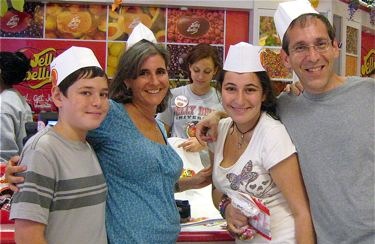There’s an old Jewish joke poking fun at religious prohibitions and the inevitable “slippery slope†that comes when one errs too far on the side of permissiveness. A soon to be married man goes to his rabbi to ask about what is allowed in the bedroom. “Can I kiss her here?†the man asks pointing to his neck. “Of course,†the rabbi replies. “How about here?†he continues, gesturing towards a more intimate location. “Absolutely,†comes the reply. “Can we do it in this position?†the man asks, twisting his arms and legs into an awkward but apparently quite admissible entanglement. The rabbi nods enthusiastically.
“What about standing up?†the man finally asks. “Oh no!†the rabbi responds in horror. “That could lead to mixed dancing!â€
While the progression in this story is meant to elicit a knowing smile, the concept ofoiding the slippery slope at all costs in Judaism is one that has both stifled innovative thinking and caused not a small amount of consternation in my own family over the years. Every time a change is proposed that’s a bit out of the box from traditional Jewish practice (usually by me although not exclusively), my wife Jody is overcome with the equivalent of a halachic hot flash.
“It’s a slippery slope,†she said, when we first agreed to eat vegetarian out of the house while traveling abroad. Because everyone knows what the next step would be: reindeer steaks au gratin! When I suggested that reading eBooks on a Kindle on Shabbat was not in the same category of Sabbath prohibitions as lighting a fire or completing a circuit and that even our rabbi was doing it, Jody’s shoulders winced in sad resignation. “It’s a slippery slope.â€
My problem with slippery slopes is that they, by their very wording, imply a downward movement; a negative retreat from the righteous path on a decline well greased for a faster descent into inescapable decadence and depravity.
Is that really true, though? Must every deviation, large or small, away from what’s perceived as traditional Judaism result in a hand wringing, Pew-cringing assimilationist nightmare in waiting? Or can the slope be an exhilarating trip into the positive; a place where creativity, joy and authenticity thrive at the end of a gently rising incline?
I don’t have to look far to get an answer. Perhaps our family’s biggest collective slippery slope of the last decade was becoming regulars at an egalitarian, musical minyan that pushes the boundaries of halacha by permitting musical instruments to be played on Shabbat and holidays. Rather than destroy the sanctity of the day, it brought us together at a time when the kids and I had become inconsolably bored with traditional shul, opting out of attendance more weeks than not, while the one person who was still into going was on the other side of the mechitza, the curtain separating men from women, leaving me alone and miserable as I muttered prayers that had long lost their meaning to me.
We heard about Jewish Renewal congregation Nava Tehila in 2005 and, even though I was already severely synagogue-challenged by this point, Jerusalem’s Nava Tehila still struck me as too much, too far out. What kind of synagogue allows you to sit next to your spouse…let alone to hold her hand while singing Lecha Dodi? And instruments – OK, music was a big part of the service by the Levites in the ancient Temple, but wasn’t that forbidden after its destruction? No, I could never…
But we tried it, out of a mix of desperation and curiosity, off and on for the first few months until the novelty wore off and we began to appreciate the way we left Friday night services invigorated and energized. We were excited by shul again! The all original musical compositions, more rock and roll than 60’s folk Carlebach, with plenty of eclectic world music flourishes, were nothing less than magical. The timing couldn’t have been better: we were back in the shul groove again.
From its original core of fifty or so people meeting in the rabbi’s living room, Nava Tehila has grown to a standing room only dance-friendly service of hundreds. The band too has grown, from a couple of guitars and a darbuka for percussion to up to 20 acoustic musicians – including at various times cello, harp, flute, saxophone, banjo and even an accordion and didgeridoo. Moreover, two of our kids joined in. Rather than dread going out on a Friday night, we now race to prepare everything on time so we can get there early enough to find a seat close to our children in the inner circle.
Although every service is wonderful, the highlight of the year is clearly Nava Tehila’s annual Simchat Torah service. On the holiday, which took place on Monday of this week, there must have been 400 of us outdoors at Jerusalem’s old Nature Museum, witnessing the Jewish Renewal custom of unfurling of the entire Torah in a giant circle, each member of the congregation grasping the top of the scroll with a tallit while the musicians serenaded us from the center. If you’ve never seen a Torah scroll open all at once, it’s truly a sight to behold.
As I reflect back on a decade of this particular slippery slope and its ultimately positive outcome, it occurs to me that the language that is so often used to vilify practices that veer from the Orthodox norm – that you are breaking Shabbat, that you are no longer shomer mitzvot (keeping the commandments) – is all wrong.
If I read The Jerusalem Post on my iPad on Shabbat, or turn off the air conditioning on a Friday night before bed because I value not harming the overly environment more than conforming to the strict letter of the law, I’m not breaking Shabbat. I’m just doing it differently. My egalitarian minyan is not OTD (“off the derechâ€), it’s just a different and equally valid way of communal celebration.
Getting my head around this concept turned out to be incredibly freeing. Guilt evaporated. The fear of slipping and sliding was gone. Because one way of observing is not better or worse than the other. As long as one professes an earnest desire to mark the day as unique from the six that preceded it, there is no inherently right or wrong way to do it. As long as one is engaged with Jewish tradition, studying it, arguing with it, loving it with all the ups and downs that come with any truly intimate relationship, who would dare to stand in judgment?
Well, actually, a lot of people. Over the last month of holidays, I devoured Shulem Deen’s riveting new memoir All Who Go Do Not Return. Deen, a former Skverer Hasid – one of the most fanatic of all haredi sects – eventually “chooses a different way of expressing his Judaism†(my words) that does not conform to the standards of his insular community. His wife warns him explicitly of the slippery slope.
“It starts with the radio and the next thing you know, you’re eating treyfe [non-kosher food] and driving on Shabbos,†she cries out. Deen is eventually deemed a heretic and essentially excommunicated. He loses his home and eventually his family along with his faith. There is no room for questioning or authenticity in Deen’s former hometown of New Square, New York.
Jay Michaelson writes a lot about authenticity – or rather the “myth†of it. In an issue of The Forward from a few years back, Michaelson wonders how many of us “share the understated assumption [that to be ultra-Orthodox] is ‘really Jewish’ [and] to be secular is not really Jewish.†He then proceeds to demolish this supposition.
“The entire notion of [Jewish] authenticity is a false projection of particular historical quirks onto an imagined ideal of ‘realness’ that artificially freezes culture and thus spells its demise,†he writes. “There is no single authentic Jewishness. Like any living culture, [Judaism] evolves over time in order to remain vibrant. Of course there are certain core values, myths and cultural traits that remain relatively constant. But bagels, bookishness and bar mitzvahs all evolved historically; none is more ‘really Jewish’ than sushi, sports or a Sweet 16.â€
“Authenticity,†he concludes, “isn’t about form. It’s about getting to what matters.†To say something as simple as you know what, this works for me – if said so meaningfully and with intent – “is a mark of integrity.â€
So let’s make a pact: let’s banish the term “slippery slope†from the lexicon of Jewish derision and embrace the dance of differences and authenticity.
Well, just as long as it doesn’t lead to mixed dancing.
I first slipped and slid over at The Jerusalem Post.


